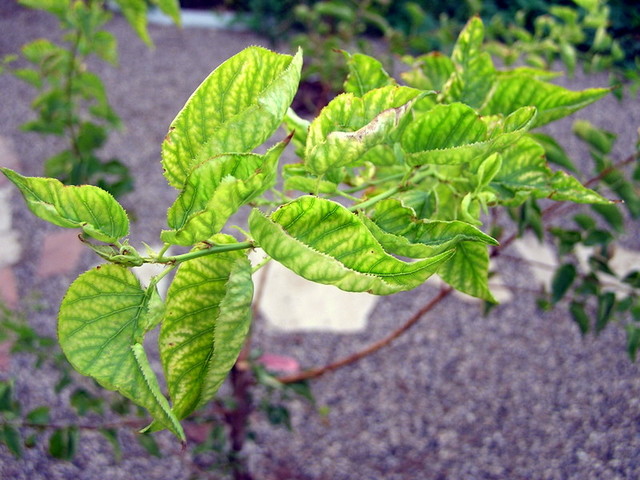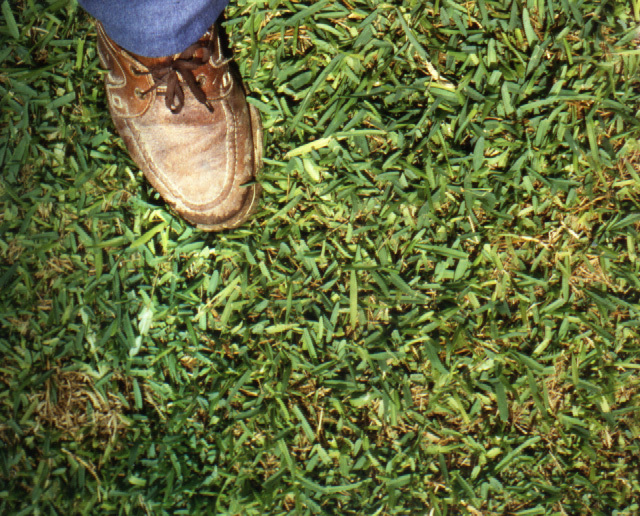At this time of year, chelated iron must be sprayed on leaves
Q: I was told I need chelated iron for my roses. So, per instructions, I added the granulated type today. My question is, how often do I do this? They do not mention this on the label, just the dosage.
A: Chelated iron means the iron is “captured” by a chemical, called a chelate, that protects it. As long as the iron is protected, it can be used by the plant. Once the iron is “let go,” it is no longer protected. In our soils and water, if left unprotected, the iron can no longer be used by the plant.
You must have mentioned that your rose bushes were yellowing to get this kind of advice. If the person helping you is knowledgeable, they would ask if the yellow leaves were on the ends of branches (new leaves) or further inside the plant on older leaves. If this is an iron problem, the yellowing would be on the newer leaves. If yellowing is on older leaves, it is a different problem.
There are two methods of correcting yellow leaves suffering from iron problems. One method is to apply chelated iron to the soil. The other method that is to spray chelated iron, mixed with water, on the leaves.
Timing, or when to apply the chelated iron, is critical depending on the method. Chelated iron must be applied to soils in the very early spring before or as new growth is emerging.
Applying chelated iron to the soil is the most effective way of correcting plants with yellow leaves because it only requires a single application.
The most effective chelated iron to apply to soils contains the chelate EDDHA in the ingredients. The more EDDHA iron on the label, the more effective it is.
At this time of year, or any time after early spring, chelated iron must be sprayed on the leaves to be effective. Applying it to the soil will not work.
Unlike soil applications, which are required only once in the spring, spraying iron on the leaves requires multiple applications for most trees and shrubs. Applications to the leaves may be required four or five times, a few days apart, to get a decent green color again.
The label may not tell you so, but always use distilled or reverse osmosis water when mixing chelated iron to make a foliar spray. Our water is very alkaline, which reduces the effectiveness of the iron chelate.
Also, use 1 teaspoon per quart of a mild liquid detergent such as Castile soap mixed into the solution as the last ingredient. Liquid detergents help move the chelated iron through the waxy leaf surface and inside the plant.
Q: I cannot find the white or yellow honeysuckle here that grew in West Texas and smells so wonderful. Perhaps you can tell me why in Odessa, Texas, fruitless plum trees are actually fruitless and don’t fall easy prey to borers.
A: The primary reason you can’t find familiar plants here is because of marketing and sales of local nurseries and gardens centers. The temperatures and soils are similar enough between West Texas and Southern Nevada, so many plants grown there would work here.
You also have Texas A&M University that is very involved with the Texas nursery industry and, through its Extension Service, is helping homeowners and local nurseries in providing a wider variety of plants that will work there.
Odessa is a little colder and not quite as hot as Las Vegas, and the soils are better for plants than most of ours — better primarily because there is more decomposed plants and animal life in the soils and they receive more rainfall. West Texas is considered semi-arid, a part of the High Plains, while Las Vegas is in the eastern Mojave Desert.
Ornamental plums, some we call purple leaf plums, are actually fruit-bearing trees that are sold for ornamental landscapes because of their showy flowers. They are from a group of fruit trees collectively called cherry plums. Actually, some cherry plums have purple foliage and some have green.
Two popular purple varieties are Thundercloud and Atropurpurea. Cherry plums require a pollenizer (another tree similar but distinctly different) to set fruit. If no pollenizer is nearby, then there is little or possibly no fruit.
Some cherry plums will set a few fruit by themselves but will set many more fruit if a pollenizer tree is close by. Fruit set without a pollenizer can depend on the climate as well. Late frosts after flowering can cause any fruit that might set to fail.
The types of borers present vary with the climate and geographical location. Also, borers are transported inside nursery plants between states. This is one method they have for getting around — by truck.
If a state like Nevada is dominated with nursery plants grown in California, these plants are more likely to have pests common to California. If plants are bought from nurseries in Texas (Texas has a large nursery industry as well), then the pests are more likely to be pests common to Texas.
Borers are decomposers. They are attracted to plants that are weakened or damaged. Our intense sunlight is tough on plants and can weaken them. Our soils are poor and can lead to unhealthy plants as well. These all make a nice hunting ground for borers.
Q: Why can’t I find St. Augustine grass here in Las Vegas. It does well in Odessa, Texas, a similar climate.
A: St. Augustine grass, grown in Arizona, does very well here and was offered for sale during the late 1980s and early 1990s. It never became popular. People in Southern Nevada preferred the all-green, winter lawn that tall fescue provided.
Overseeding Bermuda grass in the fall for a green winter lawn is not possible with St Augustine grass. Even if it could be overseeded, the winter brown lawn that St. Augustine grass provided was a hard sell for Las Vegans.
Generally, there is a lack of enthusiasm here for the warm season grasses such as Bermuda grass, Zoysiagrass, Buffalograss, St. Augustine and Seashore Paspalum. These are a few of the reasons Southern Nevada is different, horticulturally, from Odessa, Texas.
Q: I have an 18-year-old Desert Museum palo verde in my front yard. One of the limbs has two places where the sap is leaking and dripping to the ground. The sap also has hardened on the limb. Do you have any thoughts on what is causing this?
A: Sap being pushed from the limbs of many trees is very common. This includes palo verde. Sap oozing from limbs is frequently a sign of damage or stress. Cut or broken limbs can ooze sap.
Stress from watering too often can cause sap to ooze from the trunk or large limbs. Realize that this is a desert tree and that watering too frequently can damage or kill this tree.
Sometimes you can diagnose problems by looking at the sap. If the sap is clear and not cloudy or murky than this can be a good sign. However, if the sap is cloudy or murky or filled with debris, then this can be a sign something destructive is happening inside the tree.
At this point, just keep an eye on it and be careful of your irrigations. When you irrigate, put a lot of water on it once and then don’t irrigate again for a week or two. Palo verde responds to water by growing more and having a fuller canopy.
When water is limiting, growth begins to slow down and the leaves drop from the tree. Let the tree dictate how much water it needs by observing its growth and shade from its canopy.
Bob Morris is a horticulture expert living in Las Vegas and professor emeritus for the University of Nevada. Visit his blog at xtremehorticulture.blogspot.com. Send questions to Extremehort@aol.com.



























